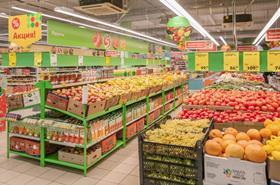
Growth in Europe’s grocery retail market is to be driven by Central and Eastern Europe (CEE), with sales in the region expanding nearly three times that of Western Europe over the next five years, according to new figures released today by international grocery research organisation IGD.
Key findings of IGD's report are that Europe’s grocery retail market is set to grow 3.8 per cent annually to 2022, with CEE experiencing dynamic growth of 6.5 per cent annually, while Western Europe will see moderate growth of 2.4 per cent annually.
“We expect stronger growth in CEE because many local retailers, including X5 Retail Group, Lenta and the discount operators, are planning extensive store opening programmes in large markets like Russia and Romania, where market consolidation is still low,' explained Milos Ryba, IGD’s head of discount and CEE. 'This will really accelerate growth across CEE and help fuel the entire grocery market in Europe.”
Ryba has also identified the key trends affecting the major retail channels across Europe: “Although bigger stores will remain the continent’s largest grocery format, we are forecasting that discount retailers will show the most dynamic sales growth to 2022, underpinned by new store openings and remodelling existing stores. The discounter chains are continuing to focus on becoming a ‘main shop’ destination for more shoppers and are increasing their presence in city centres, residential areas and on main shopping streets to help achieve this.
“Many discounters are expanding their ranges to ensure they stay relevant for today’s shoppers,' he continued. 'By tapping into shoppers’ desire for food-to-go products, easy meals for tonight and premium ranges, discounters will continue to attract new shoppers and help cement their position in the market.
“The convenience channel will also perform well, with strong sales growth forecast across Europe,' Ryba noted. 'Many multichannel retailers are focusing investment on their convenience formats, taking an adaptable approach so ranges and promotions can be flexed by location to meet a variety of shopper needs.”
The top three retailers in Europe in the convenience channel are focusing their investment in several different areas, according to Ryba.
Convenience stores are playing an increasingly important part in Carrefour’s strategy to 2022, with the retailer set to roll out a range of banners, many focused on more specialist needs, such as food-to-go and organic, to help drive growth.
Magnit’s convenience format will remain its largest contributor to sales revenue, at over 70 per cent by 2020. In the next five years, the retailer will concentrate on increasing its presence in Western Russia’s top cities, rapidly increasing the number of stores.
Finally, Tesco’s convenience strategy is shifting from rapid expansion of its store estate to making stores easy to shop and ensuring the product range is relevant for local shoppers.
“Big box stores remain a core part of European retailers’ operations, with many investing in new ways to continue attracting shoppers to stores,' Ryba highlights. 'New concepts include in-store dining and other complementary services like pharmacies and store concessions.
“Hypermarkets and supermarkets also play a key role in many retailers’ omnichannel plans, with online pick-up services often connected to big box stores, helping shoppers to combine buying in-store and online easily.
“The opportunities for growth in European grocery retail are not limited by, or to, a specific channel,' he added. 'Retailers that can offer value, inspiration and convenient shopping, coupled with low operational costs, will prosper and drive market growth.”



